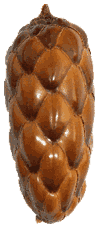 |
Palm |
 |
Palm |
Dypsis sanctaemariae is restricted to coastal forest in the northeast of the small island of Sainte Marie that lies off the east coast of Madagascar. It occurs on gentle slopes, at an elevation of approximately 10 m above sea level.
It is a small palm of the forest undergrowth, with clustering stems to 2.5 m tall and ca. 2 cm in diameter. There is a short crownshaft composed of yellow-green or crimson leaf sheaths. The leaf blades are held more or less erect forming a shuttlecock crown; they are generally up to 120 m long and can be either undivided except for a brief fork at the tip, or split irregularly into two very broad leaflets on each side of the main rib. The inflorescence is between the leaves and held erect, and carries 5–6 branches on the ca. 45 cm long peduncle. Fruits have never been seen.
Little is known about the natural history of the species.
The littoral forest throughout Madagascar is extremely fragile and much of it has been lost to shifting cultivation and coastal development. What remains on Sainte Marie is in an even more precarious state. Fires, set to clear land for cultivation during the dry season, have devastated most of the remaining natural vegetation cover on Sainte Marie.
There are no current conservation measures. Without the recognition of the biodiversity value of the remaining forest fragments on Sainte Marie, and the setting up of protected areas to include them, the prospects for survival of this species are bleak.
A demographic study of the palm should be performed and it should also be searched for in remaining littoral forest fragments occurring on the mainland nearby.
Ex situ collections should be established as a back-up strategy before the littoral forest is totally destroyed.
Dr. John Dransfield, Herbarium, Royal Botanic Gardens Kew, Richmond, Surrey, TW9 3AE, UK (j.dransfield@kew.org)
Dransfield, J. & H. Beentje. 1995.
Palms of Madagascar.
Royal Botanic Gardens, Kew.
Dransfield, J, H. Beentje, A. Britt, T. Ranarivelo & J. Razafitsalama. 2006.
Field Guide to the Palms of Madagascar.
Kew Publishing, Royal Botanic Gardens, Kew.
Dransfield, J, H. Beentje, A. Britt, T. Ranarivelo & J. Razafitsalama. 2006.
Torolalan’ireo Satrapotsy (Palmier) eto Madagasasikara.
Kew Publishing, Royal Botanic Gardens, Kew.